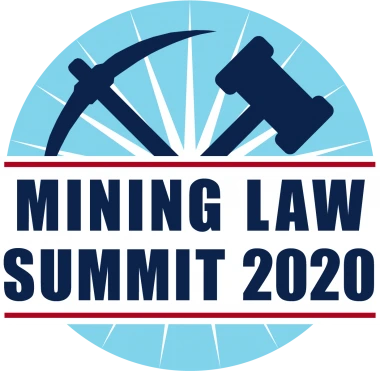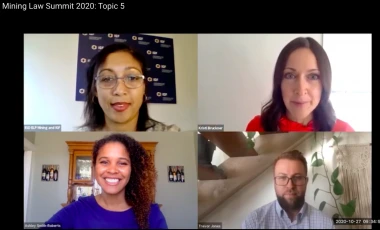Mining Law Summit 2020: New Frontiers in Community Engagement and Sustainable Development of Mineral Resources

Like many things, the UArizona Mining Law Summit looked a little different this year. With COVID-19 still posing a great threat, the summit moved online and was offered for free to anybody interested in this year’s focus, “New Frontiers in Community Engagement and Sustainable Development of Mineral Resources.”
The whole day of Nov. 6, 2020 was streamed and is still available on YouTube and packed full of seminars about a variety of different topics, from emerging demand for critical minerals, to insights on community engagement approaches. In the session “Use of Technology and Social Media as a Mechanism to Respond to Community Concerns,” Kristi Bruckner and Ashley Smith-Roberts moderated the discussion for the panelists, Trevor Jones, Flaviano Bianchini and Isabelle Ramdoo.
Bianchini, founder and executive director of “Source International”, began the panel discussion. He explained that the organization started with the idea of providing communities with instruments, knowledge, and tools they can use to understand what is happening inside their territories, “to measure somehow the impact that mining can have on their communities and from that ask for better behavior from companies, compensation from governments or companies, and the respect of their rights.”
He stressed his organization doesn’t focus too much on innovative technology, but the question of how to bring technology to those who need it and don’t have it. An excellent example is a pH meter: It is used to measure the acidity of water, but in the case of affected communities, it can be used to measure acid rock drainage, which according to Bianchini is one of the most polluting aspects of mining. The organization also uses more sophisticated technology, but the simple and accessible equipment can help the most. With the data they collect the organization can open dialogues with mining companies, communities and their governments.
Another effective example of supplying communities with data was by mapping, using small discs of cotton with Vaseline and waiting for a month to see on which cotton discs there was more or less coal dust and therefore pollution. “It's something that a community can do, and at a cost of 12 cents, even a farmer community in Mozambique was able to do it,” Bianchini says.
With more technology in and around mine sites, there will also eventually be fewer jobs for the community, but putting this technology into the hands of the community also means less pollution and a better quality of life. “There's plenty of technology, and cheap technology, so the point is to put this technology in the right hands,” Bianchini says.
Trevor Jones, the founder and CEO of Lynx Global Intelligence presented his software-as-a-service platform that provides risk data to companies and investors. “The way we try to go about that is really as a data aggregator,” says Jones. “We quickly realized that, rather than creating data, there's plenty of data already around us.” Jones and his company aggregate this data in many different ways, whether it be through SMS surveys or by translating a foreign-language radio show into English. For Jones it’s about aggregating the information so it’s usable and easy to understand for both the community and the enterprises.

Isabelle Ramdoo, the deputy director with the Intergovernmental Forum (IGF) on mining metals and sustainable development, provides strategic support to IGF member countries to optimize socio-economic benefits from the mining sectors. While at a conference, Isabelle noticed that in one room they were speaking about government policies that would make mining companies recruit more local people for certain jobs. In another room the talk was about how the mining industry was changing dramatically fast, so fast that some of the new technologies would completely wipe out the jobs those policies were searching to fill.
“The industry was busy talking about fantastic processes and how to improve them and make them more efficient and competitive,” said Ramdoo. “But they were not speaking to public authorities about what kinds of skills they will need, because the opportunities will be completely different than the kind of jobs that you have today.” There needed to be some sort of plan for the transition of the low-skill jobs needed in mine sites today, and the jobs that will require a bit more knowledge about machinery and so forth when technology grows even more. IGF is providing guidance to governments and facilitating conversations among stakeholders to try and find an approach and improve things.
They created a report that looked at how automation would affect labor jobs for the local population. “We created scenarios, 30% cut in in employment, 50% and 70% percent to try and simulate what could happen,” says Ramdoo. “None of that was based on evidence data from companies, it was hypothetical scenarios for governments to understand if they didn’t do this what could happen.” IGF is now going deeper and are doing five case-studies over a two-year period looking at South Africa, the Democratic Republic of Congo, Burkina, Chile and Mongolia.
The subsequent Q & A session touched on artisanal and small-scale mining (ASM). A problem when it comes to ASM is getting the technology into small-time miners' hands as well lack of awareness. In Bianchini’s eyes, the issue of awareness should be tackled before moving on to the distribution of technology and resources.
All panelists agreed that technology should be created and distributed to every mine and surrounding mine communities so that the experience can be best suited for everybody.
More on the Mining Law Summit 2020
Read:
Session summary "Responsible Mining Crucial for Supplying Minerals Used in Green Energy"
Watch:
Recording of all Mining Law Summit 2020 sessions
Global Mining Law Program (link to the James E. Rogers College of Law)

